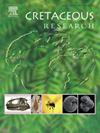A long-handed new ornithomimid dinosaur from the Campanian (Upper Cretaceous) Cerro del Pueblo Formation, Coahuila, Mexico
IF 1.7
3区 地球科学
Q1 GEOLOGY
引用次数: 0
Abstract
New ornithomimosaur material discovered from the Upper Cretaceous Cerro del Pueblo Formation (CdP) of Coahuila, Mexico represents a new genus and species of Ornithomimidae. The new taxon, Mexidracon longimanus sp. nov., is represented by an individual preserving axial and appendicular elements. M. longimanus is characterised by the following combination of characters: extreme lengthening of the metacarpals that are longer than the metatarsals, proximal end of metacarpal II with a narrow subtriangular outline, a pubic peduncle of the ilium with a flared, zig-zag articular margin that is wider anteriorly than posteriorly and an ischiadic peduncle that is similar in size to the pubic peduncle, a pubic boot where the distal margin of the anterior expansion is separated from the shaft by a deep notch, a femur that is slightly longer than the tibia, an arctometatarsalian pes, a metatarsal II that has a D-shaped cross-section, and a metatarsal IV longer than metatarsal II, among other features. A phylogenetic analysis places M. longimanus within Ornithomimidae forming a polytomic relationship with other members of this clade. The finding of M. longimanus adds to the increasing diversity and paleobiogeographic distribution of the group during the Campanian of southern Laramidia. The ornithomimosaur record of the CdP represents yet another instance of the coexistence of ornithomimids and deinocheirids spanning a wide range of body sizes within this clade of ‘ostrich’ dinosaurs.
墨西哥科阿韦拉坎帕尼亚(上白垩纪)Cerro del Pueblo组中一只长手新鸟形恐龙
在墨西哥科阿韦拉的上白垩纪Cerro del Pueblo组(CdP)发现的新的鸟齿龙材料代表了鸟齿龙科的一个新属和新种。新分类群Mexidracon longimanus sp. nov.以一个保存轴部和尾部元素的个体为代表。龙氏分枝杆菌具有以下特征组合:极端延长的掌骨长比跖骨近端结束第二掌骨窄subtriangular轮廓,髂骨的耻骨花梗带喇叭,曲折的关节边缘比后方更广泛的在前面,一个坐骨花梗相似大小的耻骨花梗,阴启动前的远端边缘扩张是分开的轴深缺口,一个略长于胫骨股骨,一种是手跖骨,一种是横截面呈d形的II跖骨,一种是比II跖骨更长的IV跖骨,还有其他一些特征。一项系统发育分析表明,长肢猴属于鸟蝇科,与该分支的其他成员形成了多组关系。这一发现增加了该类群在南拉拉米迪亚坎帕尼亚期的多样性和古生物地理分布。CdP的鸟齿龙记录代表了鸟齿类和恐爪龙共存的另一个例子,跨越了“鸵鸟”恐龙分支中各种体型的鸟齿类。
本文章由计算机程序翻译,如有差异,请以英文原文为准。
求助全文
约1分钟内获得全文
求助全文
来源期刊

Cretaceous Research
地学-地质学
CiteScore
4.10
自引率
19.00%
发文量
235
审稿时长
12 weeks
期刊介绍:
Cretaceous Research provides a forum for the rapid publication of research on all aspects of the Cretaceous Period, including its boundaries with the Jurassic and Palaeogene. Authoritative papers reporting detailed investigations of Cretaceous stratigraphy and palaeontology, studies of regional geology, and reviews of recently published books are complemented by short communications of significant new findings.
Papers submitted to Cretaceous Research should place the research in a broad context, with emphasis placed towards our better understanding of the Cretaceous, that are therefore of interest to the diverse, international readership of the journal. Full length papers that focus solely on a local theme or area will not be accepted for publication; authors of short communications are encouraged to discuss how their findings are of relevance to the Cretaceous on a broad scale.
Research Areas include:
• Regional geology
• Stratigraphy and palaeontology
• Palaeobiology
• Palaeobiogeography
• Palaeoceanography
• Palaeoclimatology
• Evolutionary Palaeoecology
• Geochronology
• Global events.
 求助内容:
求助内容: 应助结果提醒方式:
应助结果提醒方式:


